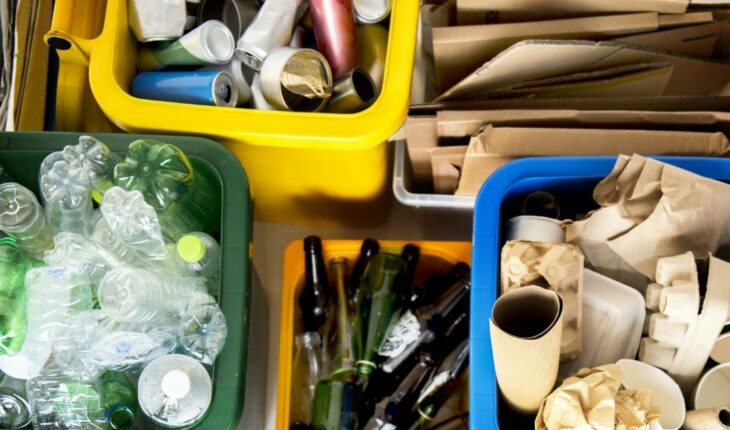Recycling is one of the great keys to migrate from a linear economy to a circular economy, with lifestyles and business models that are more sustainable and respectful of nature’s times. For many, the separation and management of recyclables is still something totally new. Many of its stages are a mystery to us, and based on that ignorance the myths about recycling arise.
It is not worth separating, everything ends together.
False! When we have a differentiated collection system, the materials that one deposits in the recyclable container arrive at a sorting center, either private or a cooperative. In these centers, each material is manually separated by category. We can have more than 30 types of classification, by type of material or characteristics such as color. In the case of localities that do not have a differentiated collection system, we can surely find cooperatives or cartoneros to which we can deliver all these materials. If we deposit everything together in the same place, we take away the possibility of having another life to the materials, wasting valuable resources and generating negative socio-environmental impacts on the environment.
Recycled products are of lower quality.
It’s relative. When we talk about materials such as paper or plastic, we have a limit on the number of times we can recycle them because precisely the product obtained from the recycling process is not of the same quality as the previous one or requires more and more virgin raw material so that it can be recycled. However, other materials such as glass or metals, can be recycled almost infinitely and without losing their properties. On the other hand, sometimes we recover materials for use in a purpose other than the original, for which they were extracted in the first instance. We can transform PET plastic bottles, the typical soda bottles, into blown plastic containers, those opaque and resistant containers such as the lavender drum. The quality of the packaging is high, but it is not comparable with the original material because they were used for completely different purposes. The important thing in these cases is to allocate the material to the most sustainable end possible, the one that allows it to have more lives.
Washing recyclables generates a huge waste of water.
It is true that recycling is not the solution to all problems with waste. Recycling processes generate an expenditure of energy, water and other resources that has a negative impact on the environment. However, when we put in the balance the impact of generating a product from scratch (in environmental, social and economic terms) and the impact of obtaining that same product but made with recycled materials, we always reach the same conclusion: recycling generates a lower impact. For example, recycled paper reduces water consumption by 86% and energy consumption by 65%, compared to paper made with virgin matter. We must bear in mind that all the links in the production chains generate an impact and make the best possible balance.
All recyclables that are separated, are recycled.
Not everything we deposit in the recyclables container is going to be recycled. In the first instance, we have to learn how to separate waste correctly. If I separate a 100% recyclable cardboard box full of grease or oil in the green bin, no matter how much it reaches the sorting center, it will not be recycled, because it is not in condition. Many times we put to recycle “just in case”. The intention is good, but it can backfire. That box traveled to a sorting center, generating greenhouse gases (GHGs) from transportation and possibly polluting other materials along the way. It arrived and was classified as discarded or “rejected”, for not being able to be recycled, taking time from the workers, occupying space and involving the use of new bags to be moved again. Finally, it is taken to a landfill, in the best of cases, or to a landfill, generating in the process more GEI.Es important to inform us well about what materials are recyclable when starting to separate, and in what conditions they should be, to do it in the best possible way.
Mixed materials cannot be recovered.
They’re harder to recover, but that doesn’t mean we can’t do it. In Argentina we do not have the necessary technologies to separate the combined materials and recycle them each on their own. But more and more viable alternatives for these materials appear, from the simplest techniques of reuse, through small entrepreneurs who look for them with processes and a little more complex, even companies that managed to manufacture products such as plastic leca and plastic wood from discards. The key is not to give up and look for a viable alternative. If in the municipality or the cooperative they do not accept a material, the ideal is to look for entrepreneurs who do receive them.
Oxo-biodegradable plastic is better than ordinary plastic.
Myth. When plastic breaks down it turns into microparticles, better known as microplastics, wreaking long-term havoc on ecosystems and our health. There are biodegradable plastics, based on corn starch or even banana peels. While these products take considerable time to degrade, they do biodegrade and generate a much smaller impact than traditional plastics. Oxo-biodegradables, present in many bags, simply consist of a traditional plastic with an oxy-biodegradable additive. This causes them to separate into smaller particles much faster, but the material remains the same, it does not degrade. It can even become even worse, as they can travel through the air and water more easily.
If there is no formal collection in my municipality, I cannot recycle.
In these cases we can go to cooperatives where we can take our recyclables or pick them up. We can also establish a relationship with a cartonero or urban recuperator in the area so that from time to time our recyclables are taken, even if it is some categories, such as cardboard and aluminum, which are easy to sell in the industry. For the most complicated materials to locate, it is best to contact entrepreneurs who reuse them. It is key that we begin to promote from the community initiatives aimed at better waste management. Citizen participation is essential, not everything is the task of governments, we can also generate changes from our place. Maite Durietz, Bachelor of Environmental Management, Sustainability Specialist and Consultant B (@unaovejaverde).





